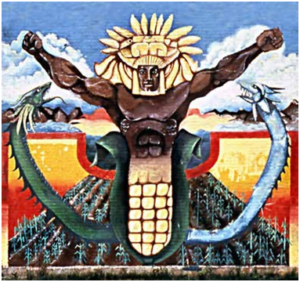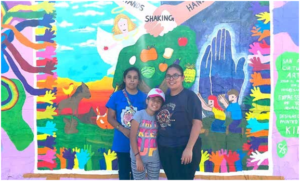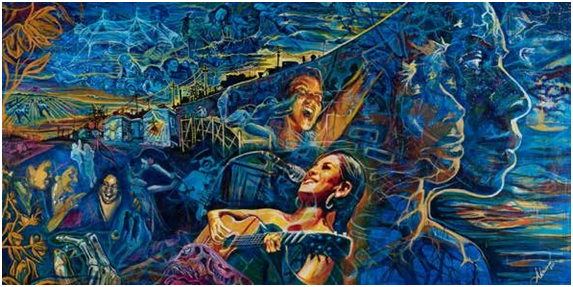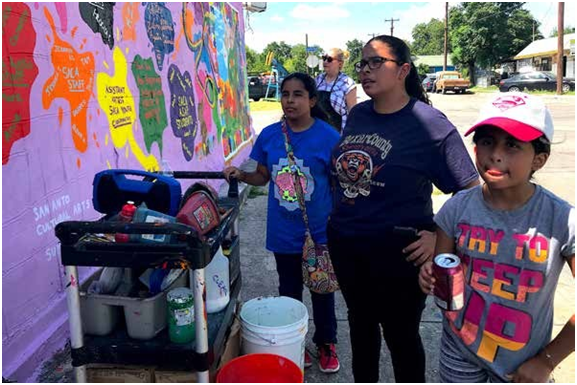By Dr. Ricardo Romo
This summer San Anto Cultural Arts (SACA) has once again matched up San Antonio youth with their artistic inspirations and SACA’s goal to beautify the Westside community. With the enrollment of two eleven year old twins, Argentina and Salome Castaneda, SACA is also achieving their goal of training a new generation of mural artists. The Castaneda girls are the youngest muralists in San Antonio, and perhaps in Texas. This past week they finished a color- ful mural on the corner of Guadalupe and Navidad
I arrived at the site of SACA’s new ‘kid’s mural” on a Thursday afternoon just as the Castaneda sisters were putting the final touches to their first ever mural. The mural on Guadalupe and Navidad was being painted on the east wall of a nondenominational church known for feeding the homeless. The mural colors were bright and uplifting, just what the house of worship requested. Lisa Castaneda, the mother of the twin girls, attended every artistic session. She beamed with pride as I asked about the project. Her twin daughters had chosen to spend the hottest days of the summer outside learning to construct murals while painting at the same time. Kids at that age are looking to be engaged. Parents prefer that their children do not spend all their time inside their home playing video games or watching television.

This year, “Midnite” Flores has been in charge of the summer programs at SACA. Flores, a native of East Los Angeles, came to San Antonio six years ago just as he was shifting from performance arts and engaging full time in painting and related creative arts. His specialty is textual abstract art. Flores has been working with SACA for two and a half years and this summer he headed the summer teaching and training classes. More than 60 young students from the ages of five to fifteen applied. The classes are free and 30 students were
selected.
The summer program has a team of ten working with students who arrive at 8am and leave at 5pm. They are fed breakfast and lunch, thanks to a grant from the Texas Department of Agriculture, and their food is delivered to them daily for the two weeks of classes.
SACA has been responsible for many of the newer murals of the Westside. A mural dedicated to mental health issues, completed by Adriana Garcia, was featured in last week’s edition.
Throughout the school year SACA provides after school programming for school-aged youngsters from 4pm – 7pm every weekday. These workshops led by professionally trained teachers and mentors include sculpting, painting, poetry, and photography. During the month of October SACA also hosted a Dia de Muertos programming for the whole family where kids and par- ents made different ofrendas and decorations for their home altars as well as for the SACA exhibition space.
San Anto Cultural Arts recently celebrated its 25th anniversary of artistic work in the Westside. SACA be- gan in 1993 when artists Manuel Castillo, Cruz Ortiz, and Juan Miguel Ramos submitted several art projects to the Inner City Development Office of San Antonio. In 1997 they officially became a nonprofit arts organization.
 In SACA’s quarter century history, they have painted more than 50 murals and published over 200 issues of El Placazo, their arts news- paper. San Anto commissions several murals a year and serves as an incubator for local artists.
In SACA’s quarter century history, they have painted more than 50 murals and published over 200 issues of El Placazo, their arts news- paper. San Anto commissions several murals a year and serves as an incubator for local artists.
Under the current leader- ship of Ben Termillo, SACA remains committed to its goal of “engaging residents and fostering the talents of youth by educating them on the history and techniques of public art while document- ing and preserving the rich history and heritage of San Antonio’s Westside.”
With a staff of five art teachers and mentors as well as a network of over 200 volunteers, SACA remains the only Westside arts organization offering year-around after school art classes–and at no charge. This year SACA enrolled over 300 students in what the organization calls “basic art principles, hands-on techniques, and mentorship skills that trans- late into creative know-how and problem-solving skills useful in school, at home, the workplace and beyond.”
II Murals are not new to the Westside. The West- side community saw its first murals in 1979 when the San Antonio Community Cultural Arts Organization (CCAO) began painting mu- rals at the Cassiano Homes close to the Laredo and Zar- zamora.

neighborhood. Founded by Anatascio Torres and Juan Hernandez and supported with Inner City Develop- ment funds, a non profit run by Patti and Rod Radle, the artists working with CAO painted more than 100 mu- rals over a ten year period. Vincent Valdez and Alex Rubio are among the better known young artists who first applied their brushes and paints to the walls of the Cassiano Homes.
In 1983 I had the pleasure of working with Torres and Hernandez in the production of a documentary funded by the Institute of Texas Cul- tures. Over the next twenty years the ITC presented our show “Painted Walls of the Barrios” thousands of times. Moreover, several of the Cassiano Homes images appeared in William Goetzmann’s 1986 western art book, The West of the Imagination.
Goetzmann, a Pulitzer Prize winning author, was a colleague of mine in the History department at the University of Texas. In preparation of his prize winning book, he requested several of the images from the Cassiano Homes which he had seen in one of my presentations. Goetzmann selected four images for his book: Aztec Corn God, Emiliano Zapata, Gregorio Cortez, and Pancho Villa-General Pershing. When I interviewed Torres and Hernandez in the mid 1980s, they were clear about their mission to beautify the neighborhood and educate the community about Latino history and culture. Tor- res and Hernandez wanted to be sure the residents of Cassiano Homes saw these murals as an improvement to the environment. The Torres team gave residents the opportunity to suggest themes and images for their walls. Torres and Hernandez also conducted surveys and interviews with the residents about images they preferred. Some of the Cassiano Homes murals appear to have been influenced by
the popular Mexican calendars distributed by the local bakeries and grocery stores during this time period. San Antonio’s proximity to Mex- ico made it possible to order calendars from Mexican vendors and printing firms. Popular calendar images in- cluded the Virgin of Guada- lupe, General Pancho Villa, and several versions of Aztec princesses and warriors.

By 1990 funding for the city’s mural projects dis- appeared and artists who had been engaged in the Cassiano Homes went on to other artistic endeavors. Valdez, who had joined the CCAO in the mid 1980s when he was thirteen years old, went on to paint a mu- ral on the outside wall of his Burbank High School. Ten years ago this mural was white-washed. School administrators claimed later not to understand its origins and significance. Valdez is one of the few artists ever to be included at the prestigious National Portrait Gallery in Washington DC. His paintings have also been collected by the Smithsonian Institute, the UT Austin Blanton Art Museum and the San Antonio McNay Art Museum. Valdez now lives and works in Houston, Texas.
Rubio continued to live and work in San Antonio, his hometown, and remains passionately committed to painting and teaching. He is currently the Artist-In- Residence for the MOSAIC Program at Blue Star Con- temporary Arts. In 2011, Rubio founded ®space, a gallery for undiscovered artists in San Antonio. Five years later he established Rubio Gallery-South, a con- temporary art gallery presenting early career artists. His most recent mural was commissioned by the San Pedro Creek Culture Park.






